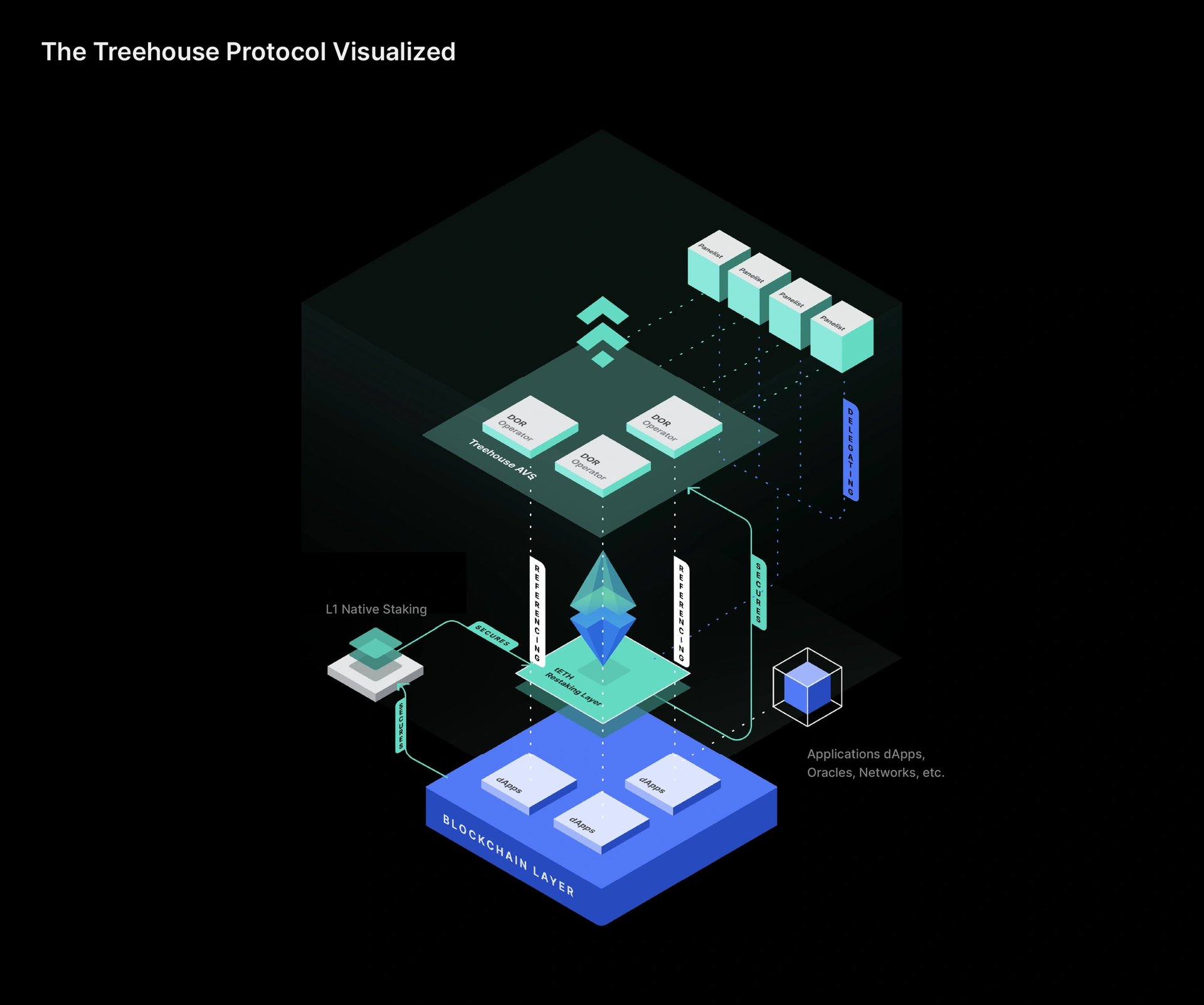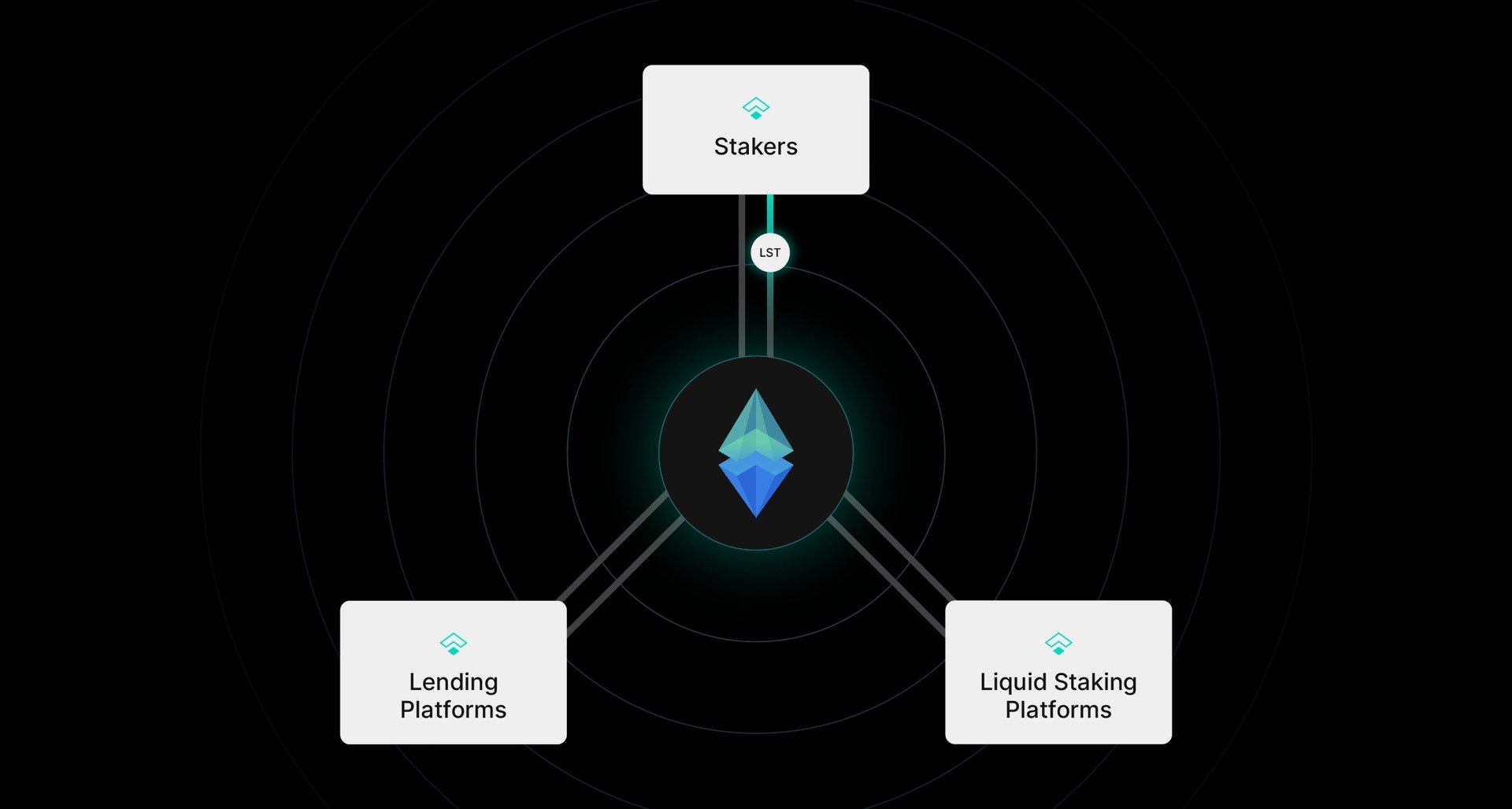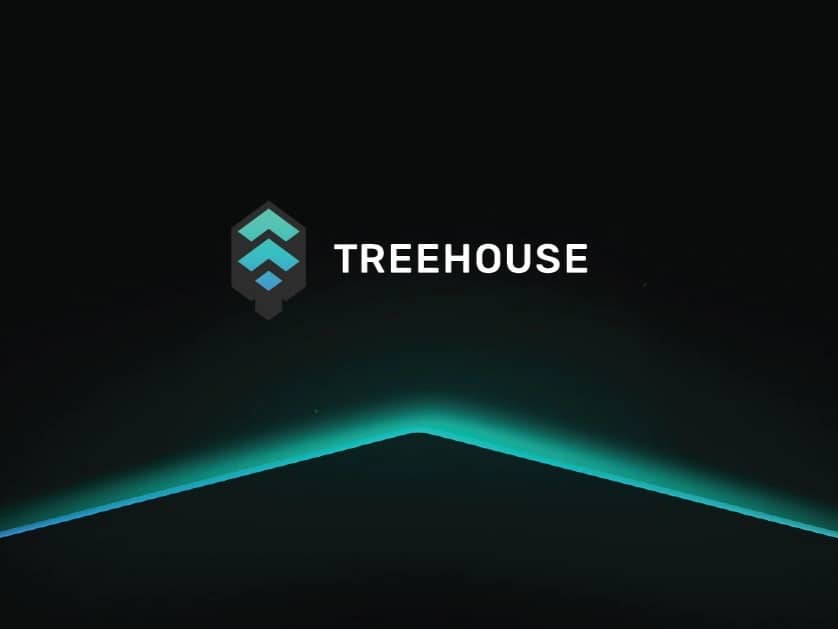Treehouse Finance
Treehouse Finance는 Treehouse 자산(tAssets) 및 분산형 제공 금리(DOR)를 도입하여 디지털 자산의 온체인 금리 벤치마크를 구축하는 탈중앙화 고정 수익 프로토콜입니다. 스테이킹(https://iq.wiki/wiki/staking), 아비트라지(https://iq.wiki/wiki/arbitrage) 메커니즘 및 합의 프레임워크를 활용하여 단편화된 금리를 통합하고 금리 기반 금융 상품 개발을 지원합니다. [1]
개요
Treehouse Finance는 디지털 자산의 고정 수익 상품에 중점을 둔 탈중앙화 프로토콜입니다. tETH와 같은 Treehouse 자산(tAssets)과 벤치마크 금리 설정 시스템인 분산형 제공 금리(DOR)라는 두 가지 핵심 구성 요소를 도입합니다. 사용자는 ETH 또는 유동적 스테이킹(https://iq.wiki/wiki/liquid-staking) 토큰을 예치하여 tETH를 발행(https://iq.wiki/wiki/minting)하고, 이는 단편화된 온체인 ETH 수익률을 통합하고 DOR 금리 설정 프로세스를 지원합니다. 거버넌스는 초기에는 개발팀이 담당하며, 시간이 지남에 따라 토큰 기반 거버넌스로 전환될 계획입니다. Treehouse는 변화하는 블록체인(https://iq.wiki/wiki/blockchain) 환경에서 비효율성을 줄이고 적응성을 유지하기 위해 스마트 계약(https://iq.wiki/wiki/smart-contract) 기반 프로세스를 강조합니다. [2] [3]
아키텍처

Treehouse는 tAssets 및 분산형 제공 금리(DOR) 시스템을 중심으로 한 탈중앙화 아키텍처를 통해 작동합니다. tETH와 같은 tAssets는 금리 아비트라지(https://iq.wiki/wiki/arbitrage)를 통해 기본 위험 없는 금리 이상의 실제 수익을 창출하도록 설계된 유동적 스테이킹(https://iq.wiki/wiki/liquid-staking) 토큰입니다. DOR은 다양한 참여자의 입력에 의존하는 기준 금리 설정을 위한 합의 메커니즘입니다.
운영자는 DOR 피드를 시작하고 유지 관리하며, Treehouse는 Treehouse 이더리움(https://iq.wiki/wiki/ethereum) 스테이킹(https://iq.wiki/wiki/staking) 금리(TESR) 곡선을 출시하는 최초의 운영자 역할을 합니다. 독점 모델과 Treehouse의 소프트웨어를 보유한 선정된 기관인 패널리스트는 금리 데이터 또는 예측을 제공합니다. 프로토콜 무결성을 보장하기 위해 현재는 사전 승인된 패널리스트만 허용됩니다. 참조자는 DOR 피드를 금융 상품에 통합하여 가격 책정 또는 결제 목적으로 금리를 활용하는 기관입니다. 위임자는 DOR 관련 업무를 위해 패널리스트에게 tAssets를 할당하지만 자산 소유권을 유지하면서 선택된 패널리스트에게 운영 권한을 부여합니다. [12]
DOR
분산형 제공 금리(DOR)는 Treehouse 프로토콜을 통해 생성된 벤치마크 금리로, 디지털 자산 시장의 금융 상품에 대한 객관적이고 검증 가능한 기준 금리를 생성하도록 설계되었습니다. 주관적인 입력이나 중앙 집중식 제어의 영향을 받는 기존 벤치마크와 달리 DOR은 거래 활동이나 지수 공식과 같은 측정 가능한 데이터를 기반으로 한 투명한 온체인 합의에 의존합니다.
이 프로토콜은 조작으로 어려움을 겪었던 LIBOR와 같은 레거시 시스템과 단일 게시 기관에 대한 의존으로 중앙 집중화 위험을 도입하는 SOFR의 단점을 해결합니다. Treehouse는 정확성, 탈중앙화 및 비종속성이라는 세 가지 핵심 원칙을 통해 이러한 모델을 개선합니다.
정확성은 게임 이론을 사용하여 유지되며, 패널리스트는 자본을 스테이킹하고 입력의 신뢰성에 따라 보상 또는 벌금을 받습니다. 탈중앙화는 개방적인 참여와 투명한 금리 계산을 통해 지원되므로 관련 전문 지식을 가진 사람이라면 누구든 기여하거나 위임할 수 있습니다. 이 프레임워크는 비종속적이므로 암호화폐(https://iq.wiki/wiki/cryptocurrency) 수익률에서 주택 담보 대출 금리와 같은 실제 금융 지표에 이르기까지 광범위한 자산에 대한 기준 금리를 생성하는 데 사용할 수 있습니다. [4]
이더리움 스테이킹 금리
이더리움(https://iq.wiki/wiki/ethereum) 스테이킹(https://iq.wiki/wiki/staking) 금리(ESR)는 이더리움(https://iq.wiki/wiki/ethereum) 생태계 내의 기본적인 “위험 없는” 수익률을 나타내며, 스테이킹 역학에서 파생됩니다. Treehouse 프로토콜을 통해 ESR은 투명하고 변조 방지 프레임워크를 사용하여 계산되므로 ESR 곡선을 구성할 수 있습니다. 이 곡선은 스테이킹(https://iq.wiki/wiki/staking) 수익률에 대한 구조화된 뷰를 제공하며, 이더리움(https://iq.wiki/wiki/ethereum) 생태계 내에서 위험 관리 및 수익률 최적화에 사용할 수 있는 스테이킹(https://iq.wiki/wiki/staking) 금리 선물 및 스왑과 같은 금융 상품 개발의 기반이 됩니다. [5]
tAssets
Treehouse 자산(tAssets)은 통합되고 수익률이 최적화된 참여를 가능하게 함으로써 블록체인(https://iq.wiki/wiki/blockchain) 네트워크 전반의 단편화된 금리 문제를 해결하도록 설계된 유동적 스테이킹(https://iq.wiki/wiki/liquid-staking) 토큰입니다. 이러한 토큰은 기본 스테이킹(https://iq.wiki/wiki/staking) 보상 이상의 금리 아비트라지를 통해 수익률을 생성하는 동시에 탈중앙화 금융(DeFi)(https://iq.wiki/wiki/defi) 애플리케이션에서 사용할 수 있습니다. tAsset 전략과 관련된 위험은 수익률 성과를 유지하고 노출을 줄이도록 적극적으로 관리됩니다. 초기 버전인 tETH는 이더리움(https://iq.wiki/wiki/ethereum)의 금리 단편화를 목표로 하며 토큰 보유를 통해 Treehouse 적극적으로 검증된 서비스(AVS)의 암호 경제적 보안에도 기여합니다. [6] [7]
tETH

tETH는 금리 아비트라지를 통해 이더리움(https://iq.wiki/wiki/ethereum)의 기본적인 지분 증명(PoS)(https://iq.wiki/wiki/proof-of-stake) 보상 이상의 수익률을 가능하게 함으로써 단편화된 온체인 ETH(https://iq.wiki/wiki/ether-eth) 금리 통합을 목표로 하는 유동적 스테이킹(https://iq.wiki/wiki/liquid-staking) 토큰입니다. 실제 수익률을 얻는 동안 tETH 보유자는 DeFi(https://iq.wiki/wiki/defi) 생태계 내에서 자산을 계속 사용할 수 있습니다. tETH는 또한 암호 경제적 보안에 기여함으로써 Treehouse의 분산형 제공 금리(DOR)를 지원하는 데 기본적인 역할을 합니다.
tETH는 아비트라지(https://iq.wiki/wiki/arbitrage) 기회가 있는 대출 및 스테이킹(https://iq.wiki/wiki/staking) 플랫폼에 ETH(https://iq.wiki/wiki/ether-eth) 또는 유동적 스테이킹(https://iq.wiki/wiki/liquid-staking) 토큰을 재할당하여 작동합니다. 시장 참여자가 ETH(https://iq.wiki/wiki/ether-eth)를 더 많이 빌리고 금리가 상승함에 따라 tETH는 차입 및 대출 활동의 균형을 맞추고 이더리움(https://iq.wiki/wiki/ethereum) 스테이킹(https://iq.wiki/wiki/staking) 금리와 일치시키는 데 도움이 됩니다. 이러한 수렴은 온체인 금리 효율성을 높이고 금리 스왑 및 옵션을 포함한 고정 수익 파생 상품의 기반을 마련합니다.
이 토큰은 또한 기존에는 기관 투자자에게만 제한되었던 아비트라지(https://iq.wiki/wiki/arbitrage) 전략에 대한 접근을 확장하여 고정 수익 활동에 대한 광범위한 참여를 가능하게 합니다. 이렇게 함으로써 tETH는 암호화폐(https://iq.wiki/wiki/cryptocurrency) 공간에서 안정적이고 예측 가능한 금융 시장 개발을 지원하며 Treehouse 프로토콜의 광범위한 금리 설정 프레임워크의 핵심 메커니즘 역할을 합니다. [8] [9]
